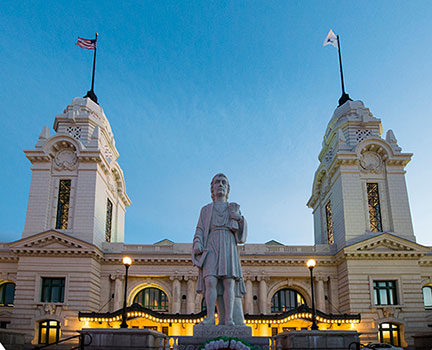By Nick Kotsopoulos
Telegram & Gazette Staff
Posted Mar 8, 2018 at 8:53 PMUpdated Mar 8, 2018 at 8:53 PM
WORCESTER – The Worcester Regional Chamber of Commerce has come out with a “white paper” suggesting strategies on how Union Station can become a destination for more than just transportation.
While the historic downtown landmark is a busy transportation hub – with more than 600,000 travelers passing through it annually – the vision that city officials have had of it becoming an active commercial center has never materialized.
Much of the retail space in the building, owned and operated by the Worcester Redevelopment Authority, is vacant or greatly underutilized.
But the chamber contends there are viable options to create opportunities for Union Station economically, according to Timothy P. Murray, the organization’s president and CEO.
With the economic momentum underway downtown, he said, now is the time to address underutilization of the site.
“There’s no doubt that Union Station is a popular transportation hub and that it has served as a major catalyst behind the development the downtown and the areas surrounding it, such as the Canal District and Shrewsbury Street,” Mr. Murray said Thursday.
“But Union Station is simply not being used to its full potential,” he continued. “The empty retail and commercial space in the building provides no meaningful economic impact. It has been a challenge to lease space in the building and efforts must be made now to fully maximize the space in Union Station.”
According to the chamber’s study, the total retail space available at Union Station is 15,176 square feet, with as many as seven individual spaces in three different sections – inside the building, near the loading docks and at street-level in the Union Station Municipal Parking Garage.
In its white paper, titled “Union Station 2.0 Report,” the chamber suggested attracting a mix of small businesses to the station that would be geared to the city’s growing college and young professional demographic.
The study pointed out that Worcester is one of the youngest cities in Massachusetts, with roughly 26 percent of its population between the ages of 20 and 34, while the median age in the city is 34.
Meanwhile, the nine colleges and universities in Worcester had nearly 35,000 students last year while employing more than 10,500 faculty and staff.
“The college-town environment will only continue to grow in Worcester, supporting local commerce and community,” the report stated.
Businesses suggested in the chamber’s report include a small grocery store/food market, a smoothie or frozen yogurt shop, a health food shop, a Mexican fast-food restaurant, an independent coffee shop and a bookstore.
The study also found that the station’s Grand Hall is underutilized on weekdays and suggested it could have food and retail kiosks. It said that would generate more annual revenue than hosting only weekend or special events there.
In addition, the study noted that the Grand Hall does not have tables or chairs to allow people to sit, eat or work while waiting for a train or bus.
“Union Station would greatly benefit from greater seating options within the Grand Hall and throughout the station, so patrons can take advantage of the free Wi-Fi offered in the building,” the study said.
Maxwell Silverman’s Banquet and Conference Center, which operates Luciano’s Restaurant in Union Station, also manages events held in the Grand Hall. But most of those events are on weekends.
“Weekend events may be popular, but why not get full value out of that space on a daily basis?” the chamber report asked. “Kiosks, such as the ones that can be found at South Station (in Boston), could be a potential way to most effectively utilize the space and create a desired economic impact.”
The report said if the spaces in Union Station are leased to capacity, the city could expect an additional $40,329 in annual tax revenue.
When Union Station was renovated and reopened in 2000, after being abandoned in 1974, the city’s goal was to make it more than just a transportation center. It was felt that for the station to succeed financially, Union Station had to have commercial, retail and office space components that would generate revenue through leases.
But, for a variety of reasons, it has been a struggle to achieve that vision.
“Union Station can be observed as a relatively empty facility except for commuter rail trips and scheduled events which create foot traffic through the station,” the chamber’s report stated. “It has been refurbished and the result is a beautiful train station and historic venue. However, the empty retail and commercial spaces provide no meaningful economic impact for the city and its residents.
“While Union Station certainly looks the part, it is time for it to realize its potential as a place that provides more than just transportation services,” the report added.
Mr. Murray said the chamber’s white paper on Union Station is part of its “Game Changers: Next Big Idea Expo and Conference” that will be held at Mechanics Hall in October. He said the chamber will be proposing a series of issues and ideas that it believes warrant further consideration as it looks to advance Worcester and the region.
Union Station is the first of those issues addressed by the chamber.
Mr. Murray said the intent of the report is to initiate a community conversation and receive feedback.
“We encourage the WRA to continue to seek new tenants to fill the available spaces to fit the needs of a changing community,” Mr. Murray said. “By leasing Union Station to capacity there would be a substantial economic benefit for the area. We also suggest that the WRA analyze the current tenant leases to evaluate whether leases can be amended to allow for new tenants and additional events that create a beneficial economic impact,” he added.
The report was produced for the chamber by Kelsey DeWolfe, Andrew Ngo, Sarah Palmer, Patrick Sullivan, Vaske Gjino and Mr. Murray.






